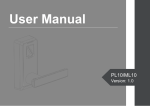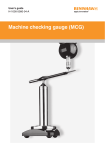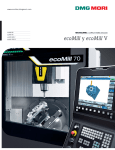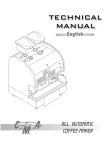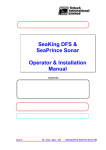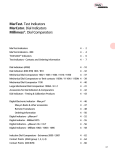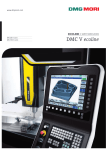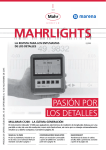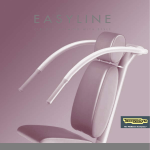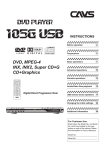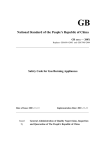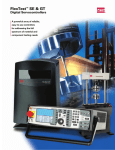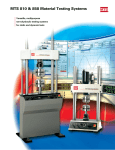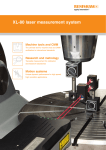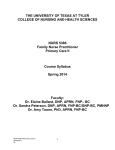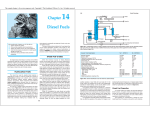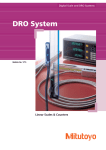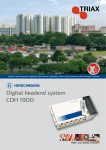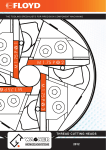Download Performance measurement systems
Transcript
Global solutions from Renishaw Renishaw is an established world leader in metrology, providing high performance, cost-effective solutions for measurement and increased productivity. A worldwide network of subsidiary companies and distributors provides exceptional service and support for its customers. Renishaw designs, develops and manufactures products which conform to ISO 9001 standards. Renishaw provides innovative solutions with the following products: Probe systems for inspection on CMMs (co-ordinate measuring machines). Systems for job set-up, tool setting and inspection on machine tools. Scanning and digitising systems. Laser and automated ballbar systems for performance measurement and calibration of machines. Encoder systems for high accuracy position feedback. Spectroscopy systems for non-destructive material analysis in laboratory and process environments. Renishaw plc, New Mills, Wotton-under-Edge, Gloucestershire, GL12 8JR, United Kingdom Tel +44 (0) 1453 524524 Fax +44 (0) 1453 524901 email: [email protected] Renishaw Inc. 5277 Trillium Blvd., Hoffman Estates, IL 60192, USA Tel +1 847 843 3666 Fax +1 847 843 1744 email: [email protected] Performance measurement systems Renishaw K. K. Across City Nakano-Sakaue, 38-1, Chuo 1-chome, Nakano-ku, Tokyo 164-0011, Japan Tel +81 3 5332 6021 Fax +81 3 5332 6025 email: [email protected] Renishaw GmbH Karl-Benz Straße 12, D 72124 Pliezhausen, Germany Tel +49 7127 9810 Fax +49 7127 88237 email: [email protected] Renishaw S.A. 15 rue Albert Einstein, Champs sur Marne, 77437 Marne la Vallee, Cedex 2, France Tel +33 1 64 61 84 84 Fax +33 1 64 61 65 26 email: [email protected] Renishaw S.p.A. Via dei Prati 5, 10044 Pianezza, Torino, Italy Tel +39 011 966 10 52 Fax +39 011 966 40 83 email: [email protected] Renishaw Iberica S.A. Edificio Océano, Calle Garrotxa 10-12, Parque Más Blau, 08820 Prat de LLobregat, Barcelona, Spain Tel +34 93 478 21 31 Fax +34 93 478 16 08 email: [email protected] ML10/EC10 measurement and calibration system Renishaw A.G. Poststrasse 5, CH 8808 Pfäffikon, Switzerland Tel +41 55 410 66 66 Fax +41 55 410 66 69 email: [email protected] Renishaw (Hong Kong) Ltd. Unit 4A, 3/F, New Bright Building, 11 Sheung Yuet Road, Kowloon Bay, Hong Kong Tel +852 2753 0638 Fax +852 2756 8786 email: [email protected] Renishaw Latino Americana Ltda. Calçada dos Crisântemos 22, Centro Comercial de Alphaville, C.e.p. 06453-000, Barueri-SP, Brazil Tel +55 11 7295 2866 Fax +55 11 7295 1641 email: [email protected] India, Bangalore Tel +91 80 5095419 Fax +91 80 5095421 email: [email protected] Renishaw’s Representative Offices The Peoples’ Republic of China, Beijing Tel +86 10 6410 7993 Fax +86 10 6410 7992 email: [email protected] The Peoples’ Republic of China, Shanghai Tel +86 21 6353 4897/5697 Fax +86 21 6353 4881 email: [email protected] QC10 ballbar system Singapore Tel +65 8975466 Fax +65 8975467 email: [email protected] Indonesia, Jakarta Tel +62 21 428 70153 Fax +62 21 424 3934 email: [email protected] Australia, Melbourne Tel +61 3 9553 8267 Fax +61 3 9592 6738 email: [email protected] Taiwan, Taichung City Tel +886 4 251 3665 Fax +886 4 251 3621 email: [email protected] Renishaw’s Liaison Office Authorised distributor South Korea, Seoul Tel +82 2 565 6878 Fax +82 2 565 6879 email: [email protected] MCG machine checking gauge email: [email protected] www.renishaw.com Corporate telephone number for Renishaw plc, New Mills: +44 (0) 1453 524524 or 07000RENISHAW ©2000 Renishaw Printed in England 0900 Part No. L-8003-2424-03 Measure, analyse and improve your machines’ performance METROLOGY IS OUR BUSINESS Real metrology solutions With over 25 years of experience in the field of engineering metrology, Renishaw has an international reputation for producing high quality measuring systems. From the touch trigger probe to the complex Raman imaging microscope, Renishaw brings real solutions to real problems. Meeting the challenges of modern industry The demands of modern industry to meet ever tighter tolerances, and the requirements of international quality standards, mean that the performance of manufacturing machinery has never been more important. To meet this demand, Renishaw produces measurement systems that assess, monitor and improve machine performance. These systems combine the best available mechanical, electronic and optical technologies which have been designed for easy use, flexibility and portability. Systems normally reserved for research laboratories and standards rooms can now be used directly on the shop-floor. The industry “standard” Renishaw’s measurement systems are accepted throughout the world as the industry standard for machine performance testing. The world’s leading laser measurement system The ML10 laser system represents the ultimate in machine tool and coordinate measuring machine (CMM) diagnostic instruments. Its 1.1 ppm accuracy provides international traceability at a performance that other systems just cannot match. When you purchase a laser system from Renishaw, you are buying the most accurate system available. You are also buying into a worldwide support network that understands machine metrology, machine service and the demands of maintaining accuracy in a production environment. CONTROL MACHINE PERFORMANCE MEASUREMENT SOFTWARE LASER MEASUREMENT SYSTEM QC10 BALLBAR SYSTEM Know the health of your machine – in 15 minutes Machine calibration can sometimes be a time consuming exercise. To help with this, Renishaw’s QC10 ballbar, with its unique diagnostic software, enables a “quick check” of machine performance. When used with a Zerodur® calibrator, the system provides traceable measuring accuracy of ± 0.0015 mm (0.00006 in). MACHINE CHECKING GAUGE SERVICE AND SUPPORT The MCG gauge is the ideal way of quickly measuring any changes in CMM volumetric performance. Its ease of use and flexibility of set-up makes it suitable for use on a range of CMMs. For useful information or ideas on system application, look for these boxes throughout the brochure. 3 CONTROL MACHINE PERFORMANCE Introducing the systems THE ML10 LASER MEASUREMENT SYSTEM Used for the comprehensive accuracy assessment of machine tools, CMMs and other positioning systems, the ML10 laser measurement system is by far the best tool for the job. THE FACTS SPEAK FOR THEMSELVES.... ● The most accurate system of its type – system accuracy of 1.1 ppm is maintained throughout its operating range of 0 – 40°C (32 – 104°F), a standard level of performance that NO OTHER competitive system can match. ● Quick and safe alignments with a tripod mounted laser – all alignment can be undertaken comfortably and safely outside the machine. No need to lose axis travel or suffer the effects of cable drag on the measurement. ● Portability – one case, a tripod and notebook PC is all that is needed for a Machine tool calibration of linear axis using laser measurement system. complete system. ● Pioneers of error compensation software – packages that correct for linear positioning errors of an axis are available for linking with most machine controllers. ● Ready when you are – careful design of the system means that it is ready to The world’s leading laser measurement system use for high accuracy measurement 15 minutes after power-up. ● Optics designed for the shop user – all optics housings are made from hard anodised aluminium, resulting in light, durable optical components that thermally acclimatise to a shop environment 10 times quicker than steel optics housings. ● Long range measurement – linear measurements can be taken on axes up to 80 metres (3200 inches) in length, with the option to SIMULTANEOUSLY measure the parallel axes of dual drive machines. ● Rotary axis calibration – the combination of the ML10 laser with RX10 rotary indexer provides the only FULLY AUTOMATIC method of rotary axis calibration on CMMs and machine tools. ● Interferometry is traceable – all Renishaw’s laser measurements, including straightness and angular, are interferometric, and are therefore traceable to the international standard wavelength of laser light. Conformance to international standards: as manufacturing industry is constantly evolving, it is important that data is captured and assessed according to the very latest standards. Renishaw understands this need and continually supports its systems and users with the latest versions. CMM space-diagonal calibration using laser measurement system. 4 International service and technical support: Renishaw’s worldwide presence means that users are never on their own. If you need advice or something special, call on Renishaw’s experience. THE QC10 BALLBAR SYSTEM The QC10 ballbar system is a recognised standard for quickly checking CNC machine tool performance on a regular basis. The system is easy to set-up, simple to run and is an essential tool for all machine shops. ● Helps to cut costs – Regular use of the QC10 ballbar results in reduced maintenance, reduced machine downtime and reduced scrap. ● Very quick testing – 15 minutes is all that is needed to assess the performance of your machine. ● Easy set-up – patented centring design makes set-up simple and quick. ● Simple to run – with its unique data capture and diagnostic software. ● Predict your maintenance – through regular use, it will be clear which machines need attention, and when. Quick and powerful testing ● Understand changes in machine performance – the unique diagnostic software turns the captured data into a prioritised list of ways to improve a machine’s performance. ● Compliance to standards – ISO, ANSI, QS and ATA. THE MACHINE CHECKING GAUGE (MCG) ● Exclusively for CMMs – for measuring repeatability and volumetric performance. ● Compliance to standards – this measurement method complies with BS EN ISO 10360-2. ● Flexible set-up – supplied with a range of extensions, the MCG gauge can be adapted to test all sizes of CMM. ● Identify changing machine performance – if the volumetric numbers are changing, so is the machine. 5 CONTROL MACHINE PERFORMANCE Why you should measure machine performance AS A MACHINE BUILDER YOU CAN... IMPROVE THE PERFORMANCE OF YOUR MACHINE Fast, accurate measurement of machine performance, quickly allows you to isolate mechanical or electrical problems and then fix them, either by repair or by optimising machine error maps. IMPROVE MACHINE DESIGN A detailed analysis of machines helps to identify the impact of new design features on machining performance. REDUCE BUILD CYCLE TIMES By keeping a record of the performance of each machine you produce, and by closely monitoring the build process, you gain good visibility of any production engineering problems. Machine buy-off test times can be reduced without the need for time consuming cutting tests. PROOF OF PERFORMANCE Customers can be reassured that their new machines meet specification as you provide them with traceable calibration results of machine performance before it leaves your factory. Superior portability allows you to respond to customer requests for on-site acceptance tests. PROVIDE A PROFESSIONAL MAINTENANCE SERVICE High quality after-sales service is a must. Using the same calibration tools in the customer’s premises, is the best way to restore the machine to manufactured specification. 6 AS A MACHINE USER YOU CAN... MINIMISE SCRAP AND IMPROVE ACCURACY OF CUT PARTS By ensuring that a machine is working to specification, the chance of scrap will be minimised. It also enables tighter tolerances to be held on jobs and improves overall accuracy and quality. MINIMISE MACHINE DOWNTIME Gain a detailed picture of how each characteristic of a machine’s performance is varying over time. Predict when maintenance work will be required for a specific machine, and establish contingency plans in advance. WIN MACHINING CONTRACTS FROM YOUR COMPETITORS When customers need confidence in the quality of your machining, calibration graphs and regular performance evaluation results of your machines are excellent proof. These can give you a valuable competitive advantage over other machining contractors, who may not perform such tests. COMPLY WITH ISO 9000 It is a requirement of the ISO 9000 series of quality standards that manufacturing and inspection equipment is calibrated, monitored and controlled. GRADE THE PERFORMANCE OF ALL YOUR MACHINES Through calibrating all your machines, you will be able to grade them according to their relative machining ability. Assigning specific toleranced jobs to machines capable of holding these tolerances, ensures that the machine is fit for the required purpose and less likely to produce scrap. EXTEND THE LIFE OF YOUR MACHINE Certain types of machine errors can lead to excessive wear in the drive system and guideways of machines. By pinpointing and eliminating these errors at an early stage, you can improve the working life of a machine. VALIDATE THE QUALITY OF A NEW MACHINE UPON DELIVERY Shipping and site installation can often have a detrimental effect on a machine’s accuracy. A performance check on the machine immediately after installation, confirms its readiness to begin work. 7 CONTROL MACHINE PERFORMANCE How and when to calibrate and test performance ANNUAL CALIBRATIONS 2001 Calibrations are typically performed on an annual basis. Using the ML10 laser measurement system to gather a comprehensive view of all the geometric and dynamic characteristics of a machine, means information obtained targets any machine maintenance that may be required. However, machine performance can vary significantly throughout a year, particularly if it has crashed or been moved. Therefore, annual calibrations should ideally be supplemented by regular machine performance checks. 200 0 1999 1. Perform full laser calibration 2. Benchmark with a ballbar ● Perform a full laser ● Immediately benchmark the calibration calibration test, measuring all geometric, positioning and motion characteristics for each axis. with the QC10 ballbar test on machine tools, or MCG gauge test on CMMs. The quick tests are now linked to the comprehensive laser calibration. INTEGRATING ANNUAL CALIBRATIONS AND REGULAR MACHINE PERFORMANCE TESTS The ML10 laser, QC10 ballbar and MCG gauge can be used as complementary tools, by exploiting each of their strengths. The ML10 laser measurement system provides the ultimate accuracy and traceability for each parameter of machine positioning and geometry. After benchmarking a calibration, the QC10 ballbar and MCG gauge can both provide frequent, regular snapshots of how a machine’s accuracy varies over time and highlight when and where problems are likely to occur. 8 Week 3 X X X X We X X X ek 2 X X X X X W eXek X X 1 X X X X X REGULAR PERFORMANCE TESTS The QC10 ballbar can evaluate machine tool performance quickly and simply, with a fully automated test procedure. In only 15 minutes, the circularity data obtained from a test allows its powerful diagnostic software to identify and quantify a wide variety of errors on a machine, from machine geometry to controller related problems. Maintenance can then be quickly focused on the identified problem areas, adjustments made and the results confirmed by performing a further QC10 ballbar test or ML10 laser measurement. Similarly, the MCG gauge can establish a benchmark volumetric accuracy value for CMMs from which trends can be ascertained at regular intervals. 3. Regularly re-check machine ● Re-check the machine with the QC10 ballbar or MCG gauge at regular weekly or monthly intervals, or following machine relocation, machine crash, or when parts begin to drift from tolerance. 4. Pinpoint problem areas Regular pre-planned checks enable a machine’s performance to be charted over time and future accuracy problems to be intelligently predicted through trend analysis. 5. Repair and re-calibrate with a laser ● After maintenance work, the machine can be re-calibrated using the ML10 laser measurement system. ● If overall machine accuracy falls below an acceptable level, use the QC10 diagnostic software to analyse and pinpoint problem areas, and for advice on appropriate maintenance work. On CMMs, it is advisable to perform a laser test to identify the specific location of an error. 9 MEASUREMENT SOFTWARE SOFTWARE DESIGNED WITH THE USER IN MIND Laser and ballbar measurement software is supplied on CD-ROM in a multilingual format for a range of languages. The user interface to both the ML10 laser and QC10 ballbar uses dedicated Windows ® 95, 98, NT4, 2000 or ME compatible software exclusively developed by Renishaw. The ML10 laser software provides the capability for both static and dynamic measurement of a machine’s linear, angular, straightness, squareness and rotary accuracy. It is supplied with dynamic, dual axis, digital indicator, electronic level, universal error compensation and on-line help capability as standard. FLEXIBILITY OF DATA COLLECTION To meet the requirements of different applications, the laser software employs an array of automatic and manual data capture methods: Manual: Keyboard, remote hand switch. Automatic: Time and position based, dynamic, encoder triggered (via the TB10 trigger box). Simultaneous dual measurement DATA ANALYSIS TO INTERNATIONAL STANDARDS Data can be collected from two axes simultaneously and then analysed independently. 10 Laser data analysed to the following standards: ISO 230-2 ANSI B5.54 ANSI B89 VDI 3441 VDI 2617 JIS-B6330 GB-10931-89 Operating within the Windows environment, data can be exported into other applications in raw format. Alternatively, analysed data can be cut and pasted into other applications, thus enabling professional presentation of test results. LINKING TO OTHER INSTRUMENTS HEWLETT PACKARD 5528 LASER SYSTEMS Renishaw’s software can be used as the interface for existing users of 5528 Hewlett Packard systems, when coupled with one of our GPIB interface kits. These kits are available in either ISA card format for desktop PCs or PCMCIA card format for notebook PCs. ELECTRONIC LEVELS AND DIGITAL INDICATORS The software is extremely flexible in enabling the capture, storage and presentation of data from electronic levels and digital indicators. The captured data can then be analysed in accordance with national and international standards. More information on system interfacing can be found on pages 32-33 MINIMUM COMPUTER REQUIREMENTS Ballbar data analysed to the following standards: ISO 230-4 ANSI B5.54 ● ● ● ● ● ● ● ● Windows® 95, 98, NT4, 2000 or ME operating system, ● An RS232 port will be required if using accessories such as error compensation software, RX10 rotary axis calibrator or the digital indicator interface. ● For the ballbar system. The computer must have at least one RS232 port available (9600 Baud). Internet Explorer 5 or later, 200MHz processor, 32MB RAM, Minimum Screen resolution 800 x 600 pixels, CD-ROM drive for software installation, 3.5” floppy drive (optional for data storage and transfer), For the laser system. If a PCM10 interface card is to be used, a single Type II PCMCIA card bus slot is required on a notebook computer. If a PC10 computer interface card is to be used, the desktop computer must have one spare 8-bit half length ISA slot for the interface card. 11 LASER MEASUREMENT SYSTEM System architecture The Renishaw laser measurement system is an ideal solution for complete calibration of machines, enabling the measurement of a wide range of geometric and dynamic characteristics. It employs a flexible, modular system architecture ensuring that it can best fit your specific measuring requirements, and grow as they grow. EC10 COMPENSATION UNIT ML10 LASER HEAD At the heart of the system are the ML10 laser head and EC10 environmental compensation unit. These core components together represent the most accurate laser measurement system available to industry with 1.1 ppm accuracy maintained over the FULL operational temperature range of 0-40 °C (32-104 °F). page 14 page 15 page 32 page 32 page 32 PCM10 INTERFACE CARD PC10 INTERFACE CARD ISA SLOT LX10 INTERFACE UNIT NOTEBOOK PC DESKTOP PC RS232/IEEE – HP5528 LASER SYSTEM – 3RD PARTY ELECTRONIC LEVELS AND DIGITAL INDICATORS 12 PCMCIA SLOT page 32, 33 MEASUREMENT OPTIONS Linear positioning accuracy and repeatability of an axis page 16 Angular pitch and yaw of an axis page 18 Straightness of an axis page 20 Squareness between axes page 22 Flatness of a surface page 24 Rotary axis/table angular positioning page 26 Dynamic characteristics of a machine page 28 13 LASER MEASUREMENT SYSTEM The laser and environmental compensation THE ML10 LASER HEAD The ML10 laser head is the core unit of the measurement system. It contains a Helium Neon (HeNe) laser tube producing stabilised laser light at 633nm. The Class II laser power rating means that it can be used without the need for special safety equipment. The single frequency laser contains sophisticated electronics for stabilisation and to interpolate and count the interference fringes. This provides true nanometre resolution measurements at feedrates in excess of 1 m/s (40 in/s). Renishaw’s ML10 system can be used for calibrating axes up to 80 m (3200 in) in length. The ML10 laser wavelength is traceable to internationally recognised length standards. Traceability of every laser is ensured via Renishaw’s in-house iodine stabilised reference laser, which in turn is referenced to the UK’s National Physical Laboratory (NPL) iodine stabilised reference laser. This provides a recognised association to the network Laser system accuracy is of national standards organisations such as: 1.1 ppm over FULL NIST (US) IGMC (Italy) NPL (India) NRLM (Japan) NIM (China) PTB (Germany) LNE or CTA (France) environmental range Laser wavelength accuracy Air refraction compensation accuracy Renishaw’s system accuracy Typical competitors system accuracy SPECIFICATION Renishaw’s material expansion normalisation accuracy Laser source Helium Neon (HeNe) laser tube (CLASS II) Laser power <1 mW Typical competitor’s material expansion normalisation accuracy 632.9906 nm (nominal) *Comparative system accuracy Long term frequency accuracy ± 0.1 ppm (parts per million) -including normalisation for material expansion Outputs RS485 from 5 pin ‘Datalink’ Power supply Operating temperature Operating humidity Weight Dimensions Units for power supplies of 100-240 volts Frequency tolerance: 45-65 Hz 0 – 40 oC (32 – 104 oF) 6 Accuracy (± µm / m) Vacuum wavelength 5 4 2 0 – 95% non condensing 1 Max weight 5.3 kg (11.7 lb) 0 335 x 176 x 75 mm (13.2 x 6.9 x 2.95 in) Typical competitive laser systems do not hold accuracy over the FULL environmental range 3 ML10 laser system – consistent accuracy over FULL environmental range 0 (32) 10 (50) 20 (68) 30 (86) Environmental temperature oC ( oF) 14 *Based on material with thermal expansion co-efficient of 10 ppm / o C THE EC10 COMPENSATION UNIT The accuracy of a laser distance measurement system is primarily dependant on how well it can compensate for the effects of air refraction changes on the wavelength of the laser. Without this compensation, accuracy of any system is significantly compromised. Recognising this fact, Renishaw has designed its environmental compensation unit (EC10) to be extremely accurate. The EC10 compensation unit continually monitors the surrounding environment by collecting data from highly accurate sensors measuring the ambient air temperature, pressure and humidity. From this data, the unit calculates the true laser wavelength using Edlen’s equation. This compensated wavelength is combined with the fringe count from the ML10 laser to give compensated distance measurements with guaranteed accuracy. In order to compensate for machine thermal expansion, the EC10 unit can also receive data from up to three material temperature sensors which can be placed in strategic positions on the machine under test. This normalises all readings to a reference temperature of 20 oC (68 oF). Thermal compensation is particularly important when performing linear measurements especially on large machines or machines made of high expansion materials. The EC10 compensation unit can also be used as a stand-alone environmental ‘chart’ recorder. = ± 0.1 ppm = ± 1.0 ppm = ± 1.1 ppm = up to ± 3.0 ppm = ± 1.0 ppm* = ± 3.0 ppm* SPECIFICATION METRIC IMPERIAL Air temperature range 0 – 40 oC 32 – 104 oF Air temperature accuracy ± 0.5 oC ± 0.9 oF 750 – 1150 mbar 22.43 – 34.40 in Hg ± 2.2 mbar ± 0.06 in Hg Air pressure range Air pressure accuracy Relative humidity range Relative humidity accuracy 0.000060 Wavelength compensation accuracy 0.000048 0.000036 0.000024 0.000012 0 40 (104) Accuracy (± inches / ft) 0.000072 0 – 95% (non condensing) 20% RH ± 1.0 ppm (parts per million) Material temperature range 0 – 40 oC 32 – 104 oF Material temperature accuracy ± 0.1 oC ± 0.18 oF Power supply Weight Dimensions Specific units for power supplies of 100, 110, 220, 240 volts Voltage tolerance: ± 20% Frequency tolerance: 45-65 Hz 4.0 kg 8.8 lb 335 x 176 x 75 mm 13.2 x 6.9 x 2.95 in 15 LASER MEASUREMENT SYSTEM Linear measurement This is the most common form of measurement performed on machines. The system measures linear positioning accuracy and repeatability by comparing the position displayed on a machine’s readout with the true position measured by the laser. These values can then be viewed, printed and statistically analysed by the system software to national and international standards. On many of today’s machine tools, it is also possible to take this process one step further and automatically download the measured data to a compensation table in the machine’s controller. In this way, a machine’s positioning accuracy can be verified and significantly improved quickly and easily. Linear optics SET-UP The components used in this measurement comprise: Linear beam-splitter Retro-reflectors Targets (for easy optical alignment) In linear measurement, one retro-reflector is secured to the beam-splitter, to form the fixed length reference arm of the interferometer. The other retroreflector moves relative to the beam-splitter and forms the variable length measurement arm. The laser system tracks any change in the separation between the measurement arm retro-reflector and beam-splitter. To mount the optics on a machine, a range of accessories and fixtures is available. There are additional accessories which can be supplied to help measurement set-up and data capture. These are described on the system accessories section on page 30. X axis linear positioning measurement on a VMC Long range retro-reflector and periscope When measuring axes of lengths above 40 metres, the long range version of the laser head, ML10X, and patented long range linear optics are required. For measurement of dual or tandem drive machines, connect two laser systems together with the DUAL AXIS SOFTWARE. Refer to page 32. 16 Linear ● Highly durable – the aluminium optics housings, including threads, are all hard-anodised, corrosion proof and shock resistant. ● THE POWER OF AUTOMATIC LINEAR ERROR COMPENSATION BEFORE Improved dynamic response – with less than half the weight of steel optics housings, machine loading is reduced. ● AFTER Quick thermal acclimatisation – aluminium optics acclimatise 10 times quicker than steel optics. ● No thermal drift problems – the interferometer is remote from the heat of the laser head, with the laser heat source remaining outside the machine. ● Easier set-up – the remote interferometer can be fitted to specific areas of interest on a machine, without loss of axis travel. This also allows for multiple axis measurements to be made from one position, without the need to re-align the laser. ● External laser alignment – tripod mounted laser makes for easy alignment outside machine. ● Easier long-range alignment – the larger retro-reflector gives an easy target to hit and returns more laser light, even in turbulent air. The unique design of linear, angular and straightness optics enables easy interchange for different measurements without having to re-align the laser. With the addition of a linear error compensation package, the data obtained from a calibration cycle is used to calculate compensation values, which can then be fed into a machine’s controller. Once the compensation has been completed, a final laser check ensures that a machine’s positioning accuracy has been significantly improved. These packages now include a compensation “wizard” and session progress indicator to make axis compensation even easier. The software can interface with many of today’s machine controllers including: Fanuc 0M, 0T. SPECIFICATION METRIC IMPERIAL Linear measurement (standard range) 0 – 40 m 0 – 1600 in 0 – 80 m 0 – 3200 in Fanuc 10, 11, 12, 15, 16, 18, 20, 21. NUM 750, 760, 1060. (long range) Mazak M-Plus, M2, M32 Siemens 810, 840C, 850, 880 Accuracy (with EC10 compensator) ± 1.1 ppm (parts per million) Resolution 0.001 µm 0.1 µin Maximum velocity 60 m/min (1 m/s) 2400 in/min (40 in/sec) Velocity measurement accuracy Contact Renishaw if your required controller is not on the above list. ± 0.05% % = percentage of displayed value 17 LASER MEASUREMENT SYSTEM Angular measurement Pitch and yaw angular errors are among the largest contributory factors to positioning inaccuracy in machine tools and measurement accuracy errors on CMMs. Yaw errors can be caused by a machine moving unevenly along slack guideways, whereas pitch errors can be caused by bowing effects in these guideways. SET-UP The components used in this measurement comprise: Angular beam-splitter Angular retro-reflector Angular optics Targets (for easy optical alignment) For measurement set-up, the angular beam-splitter optic is best mounted in a fixed position on a machine, for example, the spindle on a moving bed machine tool or granite table on a CMM. The retroreflector optic is then mounted to the moving part of the machine, for example, the bed of a machine tool or probe-head of a CMM. The measurements are made by monitoring the change in relative angle between the beam-splitter optic and the reflector optic. X axis pitch measurement on a moving bed VMC Angular optics can also be used to measure the flatness of CMM table and surface plates. Refer to page 24. Rotary axes can also be calibrated using angular optics in combination with the RX10 rotary indexer. Refer to page 26. 18 Angular ● Highly durable – aluminium optics housings, including threads, are all hardanodised, corrosion proof and shock resistant. ● Reduced machine loading – with less than half the weight of steel optics, machine loading is reduced. This is especially relevant if measuring pitch errors on horizontal arm CMMs. ● Quick thermal acclimatisation – aluminium optics housings acclimatise 10 times quicker than those made from steel. ● No thermal drift problems – the interferometer is remote from the heat of the laser head, with the laser heat source remaining outside the machine. ● Traceability – interferometry directly benefits from the traceability of the laser This is a typical plot captured when performing an angular measurement. wavelength. PSD/CCD/Quad cell based systems do not. ● Accuracy – interferometry offers more accuracy and linearity with less sensitivity to air turbulence noise, compared to PSD/CCD/Quad cell based systems. ● For single set-up of both linear and angular measurements, contact us to find out more about our special optics combination kits. Easier set-up – the remote interferometer can be fitted to specific areas of interest on a machine, without loss of axis travel. This also allows for multiple axis measurements to be made from one position, without the need to re-align the laser. ● Convenience – moving optics have no cables to drag or snag, for best accuracy and convenience. ● Flexibility – the software also supports angular measurements using electronic levels. SPECIFICATION Axial range Angular measurement range Angular accuracy Resolution METRIC IMPERIAL 0 – 15 m 0 – 590 in ± 175 mm/m ± 10o ± 0.6%* ± 0.5 ± 0.1M µm/m ± 0.6%* ± 0.1 ± 0.007F arc sec 0.1 µm/m 0.01 arc sec Where M = measurement distance in metres; F = measurement distance in feet % = percentage of calculated angle * Higher accuracy angular optics of ± 0.2% and better can be supplied to special order 19 LASER MEASUREMENT SYSTEM Straightness measurement Straightness measurements highlight any bending component or overall misalignment in the guideways of a machine. This could be the result of wear in these guideways, an accident which may have damaged them in some way, or poor machine foundations that are causing a bowing effect on the whole machine. This straightness error will have a direct effect on the positioning and contouring accuracy of a machine. SET-UP The components used in this measurement comprise: Short range straightness optics Straightness beam-splitter Straightness retro-reflector For measurement set-up, the straightness reflector must be mounted to a fixed position on a machine. The straightness beam-splitter should then be mounted to the moving part of the machine. There are two kits available for measuring both shorter axes (0.1 – 4.0 m) and longer axes (1 – 30 m). X axis straightness measurement on a moving bed VMC If straightness measurements are taken on two axes, it is possible to assess parallelism. It is also possible to measure squareness errors between these axes. Refer to page 22. 20 Straightness ● Easier set-up – geometry of the patented straightness retro-reflector gives nonoverlapping output and return laser beams, making alignment far easier than with other systems. ● Best long-range performance – PSD/CCD/Quad cell based systems can suffer from noise and accuracy problems, particularly on long range measurement. ● Convenience – moving optics have no cables to drag or snag, for best accuracy and convenience. ● Flexibility – the software also supports straightness measurements using digital indicators and straight edges. Long range straightness optics This is a typical plot captured when performing a straightness measurement. When measuring vertical straightness in a horizontal axis, or straightness in a vertical axis of a machine, a straightness accessory kit is also required for set-up. Straightness accessory kit SPECIFICATION Axial range (short range) (long range) Straightness measurement range Accuracy (short range) (long range) Resolution (short range) (long range) METRIC IMPERIAL 0.1 – 4.0 m 1 – 30 m 4 – 160 in 40 – 1200 in ± 2.5 mm ± 0.1 in ± 0.5% ± 0.5 ± 0.15M2 µm ± 0.5% ± 20 ± 0.5F2 µin ± 2.5% ± 5 ± 0.015M2 µm ± 2.5% ± 200 ± 0.05F2 µin 0.01 µm 1 µin 0.1 µm 10 µin Where M = measurement distance in metres; F = measurement distance in feet % = percentage of displayed value 21 LASER MEASUREMENT SYSTEM Squareness measurement Squareness measurement determines the out-of-squareness of two nominally orthogonal axes, by comparing their straightness values. Squareness errors could be the result of wear in machine guideways, an accident which may have caused damage, poor machine foundations or misaligned home position sensors on gantry machines. This squareness error will have a direct effect on the positioning accuracy and contouring ability of a machine. SET-UP The specific component required for this measurement is: Optical square + bracket. In addition to the optical square, straightness optics and a straightness accessory kit are also required for set-up (see opposite). Other set-up accessories may also be required, depending on what axes are being measured and the configuration of the machine. Optical square As a quick alternative for measuring squareness on machine tools, why not use the QC10 ballbar? X-Z axis squareness measurement on a VMC Refer to page 34. On smaller machines, the limited working volume can make laser squareness measurement inconvenient. Instead, why not use a granite square and connect a digital indicator to the Renishaw squareness measurement software? Refer to page 33. 22 Squareness ● Easier set-up – geometry of the patented straightness retro-reflector gives nonoverlapping output and return laser beams, making alignment far easier than with other systems. ● Best accuracy – the optical square provides better accuracy than other systems due to the premium grade optics used (± 0.5 arc sec). ● Flexibility – the software also supports squareness measurements using digital indicators and square. This is a typical plot captured when performing a squareness measurement. Straightness optics SPECIFICATION Range Accuracy (short range) (long range) Resolution Straightness accessory kit METRIC IMPERIAL ± 3/M mm/m ± 2000/F arc sec ± 0.5% ± 2.5 ± 0.8M µm/m ± 0.5% ± 0.5 ± 0.05F arc sec ± 2.5% ± 2.5 ± 0.08M µm/m ± 2.5% ± 0.5 ± 0.005F arc sec 0.01 µm/m 0.01 arc sec Where M = measurement distance in metres of the longest axis; F = measurement distance in feet % = percentage of displayed value 23 LASER MEASUREMENT SYSTEM Flatness measurement This measurement is performed to check the accuracy of CMM tables and all types of surface plate. It determines whether any significant peaks or troughs exist and, in turn, quantifies them. If these errors are significant to the application of the flat surface, then remedial work, such as further lapping, may be required. SET-UP The specific components used in this measurement comprise: Base (50mm) Flatness mirrors and bases Base (100mm) Base (150mm) Flatness mirrors Angular optics Angular measurement optics are also required to attach on top of the flatness bases. These are available separately and are shown in the angular measurement section. Refer to page 18. The angular retro-reflector is mounted on one of three lengths of flatness foot-spacing base. The size of base used depends on the size of surface to be tested and the required number of points to be taken. The angular beam-splitter is mounted on the flatness mirror base. If you currently use FEDERAL PRODUCT’S electronic levels for flatness measurement, why not connect to the Renishaw flatness measurement software? Refer to page 33. 24 Flatness ● No thermal drift problems – the interferometer is remote from the warmth of the laser head. ● Traceability – interferometry directly benefits from the accuracy and traceability of the laser wavelength. PSD/CCD/Quad cell based systems do not. ● Easier set-up – the flatness mirrors are non-slip and fully adjustable for both pitch and yaw for simple, quick alignment. ● Flexibility – the software supports flatness measurement using electronic levels. It can also support both Grid and Moody plot techniques. ● Single laser positioning – all measurement lines can be achieved from a single laser position. Before making any measurements, a ‘map’ of the measurement lines should be marked out on the surface. The length of each line should be an integral multiple of the foot-spacing base selected. There are two standard methods of conducting flatness measurements: These are the typical plots obtained from a flatness measurement. The top graph shows a Moody plot type whilst the bottom shows a typical Grid plot type. a) Moody method – in which measurement is restricted to eight prescribed lines. b) Grid method – in which any number of lines may be taken in two orthogonal directions across the surface. SPECIFICATION METRIC IMPERIAL Axial range 0 – 15 m 0 – 590 in Flatness measurement range ± 1.5 mm ± 0.06 in ± 0.6%* ± 0.02M2 µm ± 0.6%* ± 0.08F2 µin 0.01 µm 1 µin Accuracy Resolution Where M = length of the diagonal in metres; F = length of the diagonal in feet % = percentage of calculated flatness * Higher accuracy angular optics of ± 0.2% and better can be supplied to special order 25 LASER MEASUREMENT SYSTEM Rotary measurement On many machines, it is often forgotten how the accuracy of a rotary axis is important to overall system accuracy. This could be the rotary axes on 4 and 5 axis machine tools or the rotary table on a CMM. In line with the fundamental importance of rotary axis accuracy, recent national and international standards have made strong provision for their measurement. It is for this reason that Renishaw has developed a specific rotary axis calibration system, the RX10, to be used in conjunction with its laser system. The patented method of calibration has revolutionised measurement of rotary axes. Automated testing now enables rotary axes to be checked in just 25 minutes and at any angular position. This represents a massive time saving of more than 5 hours over traditional methods such as auto-collimators and optical polygons. RX10 rotary indexer SET-UP The components used in this measurement comprise: RX10 rotary indexer RX10 controller/power supply Angular measurement optics are also required to attach to the top of the indexer. These are available separately and are shown in the angular measurement section. Refer to page 18. The RX10 features an extremely accurate Hirth-coupling design that guarantees quality and reliability of the indexer along with the accuracy of the laser. With its built-in calibration routine, centring and other set-up inaccuracies are easily eliminated. The system will operate horizontally, vertically or even upside-down for easy calibration of different orientations of rotary axis. RS232 CONNECTION TO PC Controller /power supply To automatically calibrate rotary tables or axes that lift before rotating, ask about our Lifting Table Accessory Kit. 26 Rotary BEFORE ● Easier set-up – the indexer performs an automated calibration routine to eliminate set-up errors, therefore there is no need to accurately centre the system. ● Quick, automated calibration – the indexer is motorised for lock, unlock and rotate movements to enable automatic alignment and tracking without any operator or machine intervention (ideal for CMMs). ● Flexibility – can calibrate any angle with accuracy, even multiple revolutions. AFTER A rotary axis can be calibrated through five easy steps: 1 Attach a standard angular retro-reflector to the RX10 rotary indexer. 2 Attach the RX10 rotary indexer to the axis under test by clamping the mounting plate to the table. 3 Attach the angular beam-splitter optic to a stable independent mounting. 4 The rotary axis is calibrated by rotating it sequentially through a number of angular targets as pre-selected in Renishaw’s calibration software. Laser readings are taken at each position. 5 As the axis rotates, the RX10 rotary indexer is counter-rotated automatically to ensure that the laser beam is returned back to the laser. Recent international standards state that a rotary axis should be calibrated in a number of ways, which include: SPECIFICATION The two graphs show errors in a rotary axis both before calibration and after repair work has been carried out. METRIC Angular range Indexing accuracy IMPERIAL unlimited ± 5 µm/m ± 1 arc sec 0.2 arc sec 0.1o increments through 5o. Repeatability 1 µm/m 3o intervals through 360o . Mounting Top or bottom faces for spindle or table location Operation Vertical or horizontal o o o o At 0 , 90 , 180 and 270 positions and nine further random angular positions through 360o. It is extremely difficult, if not impossible, to complete these measurements using autocollimators and optical polygons. Control Operating temperature Max velocity of indexer table Automatic via RS232 to PC 0 – 40 oC 32 – 104 oF 30rpm when the measurement step size is less than 10 degrees 2rpm when measurement step size is more than 10 degrees 27 LASER MEASUREMENT SYSTEM Dynamic measurement The dynamic measurement capability of Renishaw’s laser system adds a new dimension of flexibility and power. It enables real-time measurement of motion characteristics of machines’ systems to be made in addition to the traditional static tests described earlier in this section. Only specialised equipment can normally pinpoint such characteristics. This greatly extends the capability of the laser system and makes it an essential tool in machine CONDITION MONITORING programmes. This software can be used to evaluate acceleration, vibration, velocity and servo control performance. This is extremely useful for assessing the performance of many different types of machines used in industry, not just CMMs and machine tools. Other machines that benefit from the system include: Robotic pick and place machines Surface mount machines Hydraulic and pneumatic systems Reciprocating and positioning systems Optical stages Printing presses Dynamic software PCB drilling/routing machines PCB printing machines This measurement capability is supplied as part of the standard laser software package and requires no additional hardware other than the optics for the specific measurement being performed. These real-time measurements allow certain machine error characteristics to be highlighted and quantified. For example: Pre-load and hysteresis of ballscrew and nut mechanisms Positional stability and encoder performance Resonance characterisation of drive motors, spindles and other systems Feedrate accuracy, stability and interpolation accuracy Control-loop optimisation 28 Dynamic Vibration analysis ● Powerful vibration analysis – integrated FFT (Fast Fourier Transform) routines give a detailed frequency spectrum enabling identification of vibrations and the pinpointing of their source. ● Optics versatility – the software supports dynamic data capture and analysis using linear, angular or straightness optics. ● High capability – using a single frequency laser system provides true nanometre resolution at feedrates up to 1 m/s with 5000 Hz sample rate and no acceleration limit. ● Flexibility – data can be taken in response to internal timebases, or in synchronisation with external triggers at rates up to 4000 Hz. Using the dynamic measuring capability, the following measurements can be performed: FFT frequency analysis Displacement against time Velocity against time Acceleration against time Vibration amplitude and frequency Used in conjunction with the TB10 trigger box, dynamic software is ideal for Displacement against time Velocity against time inspecting ballscrew assemblies. Refer to page 31. Acceleration against time SPECIFICATION METRIC Sampling rates Linear displacement accuracy IMPERIAL 10 – 5000 Hz ± 1.1 ppm (parts per million) Linear velocity accuracy ± 0.01% Linear acceleration accuracy ± 0.01% Time accuracy ± 0.14% Resolution 0.001 µm 0.04 µin Servo response analysis % = percentage of displayed value 29 LASER MEASUREMENT SYSTEM System accessories OPTICS ACCESSORIES OPTICS MOUNTING KIT This kit provides the essential elements required to mount the Renishaw optics to a machine. Optics can be easily interchanged without the need to re-align the laser. It comes with hard anodised aluminium mounting blocks, stainless steel pillars and bases for the optimum combination of portability and durability. They also incorporate M8 threads for attachment to standard magnetic bases or Renishaw’s CMM probe heads. SWIVEL MIRROR FIXED TURNING MIRROR This mirror can be used as an alignment aid for ANSI B5.54 diagonal measurements. It is also useful when measuring slant-bed lathes. Clamping screws allow the mirror to be easily attached to measurement optics. This mirror reflects the laser beam through 90o. Like the swivel mirror, it can attach to the measurement optics to aid optical setup and is used primarily when there is restricted access to the required axis of measurement. BEAM STEERER LS350 This unique* optic provides easy angular adjustment of the laser beam in both horizontal and vertical planes, making laser alignment a simple one step process. The beam steerer speeds up linear, angular and straightness measurements, whether in-line or at 90°. The optic is also compatible with the linear/angular combination kit and swivel/fixed turning mirrors. Clamping screws allow the beam steerer to be easily attached to measurement optics. *Patent applied for. SPECIFICATION Steering range METRIC IMPERIAL +/-35mm/m +/-2° (imperial) TRIPODS STANDARD TRIPOD COMPACT TRIPOD This tripod offers the widest adjustment range for the mounting of the laser. It can be supplied with a hard-wearing carrying case for safe transportation and storage. (Note: the mounting stage is stored in the supercase, not this case). This tripod’s major benefits over the standard tripod is its reduced size when collapsed, and its smaller carrying case. It too can be supplied with a carrying case, which is both rugged and lightweight. (Note: the mounting stage is stored in the supercase). 30 CASES Portability of laser measurement systems is extremely important. This is especially true for mobile calibration companies or organisations based in a number of different geographical locations. Renishaw’s laser system has been designed with this in mind and comes with a range of carrying cases to complement the size of system. SUPERCASE KIT This case is capable of housing the comprehensive range of optics and equipment of the laser system. This includes ML10 laser head, EC10 compensation unit and all optics kits, sensors, cables and the tripod stage. It is extremely durable, with built-in dust and pressure seals, giving the best protection to the system. It comes with an accompanying cart, which attaches directly to the case, and padlock for added security. The compact tripod can be attached to the case and cart to provide easy portability of the complete system. SMALL CARRYING CASE LARGE CARRYING CASE OPTICS CARRYING CASE This case is designed to hold either an ML10 laser head or EC10 compensation unit along with environmental sensors. This case can house an ML10 laser head, EC10 compensation unit and sensors, cables, linear optics, angular optics and flatness kit. This carrying case can hold the straightness and squareness optics and their associated accessories. DATA CAPTURE ACCESSORIES HAND HELD SWITCH This enables remote datuming of the laser and manual data capture. It is ideal in applications where the machine’s controller is far from the point of test. It has a built-in safety feature to prevent accidental datuming and comes with 10 metres of cable which may be extended in 5 metre increments, if necessary. TB10 QUADRATURE TRIGGER BOX This device monitors the position feedback signals between a machine’s encoders and its controller and feeds trigger signals to the Renishaw laser system. This allows synchronisation of data capture from the ML10 laser head to scale position or movement. It is primarily used in applications such as ‘on-the-fly data capture’ or for monitoring scale errors, so a machine can be driven along an axis without stopping to collect data for position, angle, straightness etc. This mains-powered unit works with TTL quadrature or analogue current loop encoders and triggers the laser measurement at regular user-defined intervals. 31 LASER MEASUREMENT SYSTEM System interfacing LASER INTERFACES PCM10 – INTERFACING WITH NOTEBOOK PCs To maximise portability and performance, Renishaw has developed its own PCMCIA (PCCARD type II) interface to connect its laser system to notebook PCs. Whilst other systems rely on full length ISA bus cards, or slower RS232 ports which limit performance, Renishaw’s PCM10 interface supports a 1 Mbit/sec link allowing data capture at 5000 readings/sec, at feedrates of 1 m/sec, whilst still maintaining true nanometre resolution. There is no need to use a bulky desktop PC or docking station with the Renishaw PCM10 interface. PC10 – INTERFACING WITH DESKTOP PCs GPIB – INTERFACING TO AN HP5528 SYSTEM The PC10 card provides an identical level of performance as the PCM10 interface and is used when connecting to a desktop PC or docking station with ISA slots. The PC10 card is supplied as a half length ISA card. For users of the HP5528 system who prefer Renishaw’s calibration software, choose between the GPIB/ISA card or GPIB/PCMCIA card formats to suit your computer.* LX10 – FOR INTERFACING WITH CUSTOM SOFTWARE The LX10 interface provides all the benefits of the ML10 laser system hardware without having to modify existing software*. The unit can be switched to emulate the HP5528 with no loss of resolution or accuracy. It also enables the ML10 system to interface with PCs with no expansion card or PCMCIA facilities, by using the PC’s RS232 port. Trigger pulse input/output ML10 laser Existing calibration or diagnostic software RS232/IEEE * Not compatible for dynamic measurement. LYNX EC10 DUAL AXIS CALIBRATION A. Laser B. Interferometer C. Retroreflector D. Material temperature and environmental pick-ups In some installations, one axis is controlled by two drives and two feedback systems (eg “SPAR MILL” and large dual beam type CMMs). In this instance, a second interface card, coupled with dual axis software, provides the capability to automatically capture data of parallel axes simultaneously. Dual-axis measurement software is provided as part of the standard laser software package. C C B D A D B A 32 PC INSTRUMENT INTERFACES Instrument interfaces give you the capability of displaying, recording and analysing your data, using Renishaw’s calibration software. ● Access Renishaw’s powerful suite of software for angle, straightness and flatness data capture when using electronic levels or digital indicators. ● Analyse data to national and international standards. ● Offers a consistent user interface. ● Single location for data storage, retrieval and back-up. ● Increase your choice of measurement instruments, ● Unified presentation of calibration graphs, whatever the allowing your preferred method to be assigned to each measurement. measurement technique. DIGITAL INDICATOR INTERFACE This interface accepts data from both the FEDERAL PRODUCT’S µMAXµM and MITUTOYO’S DIGIMATIC digital indicators. Output data from the indicator through a specially developed interface, is automatically converted into a format which can be used by Renishaw’s calibration software. The kit is easy to install and comprises: electrical interface, serial port adaptor cable, software and manual.* What can you measure? Axis straightness – using digital indicator and straight edge. Axes squareness – using digital indicator and square. Axis roll – using two digital indicators, straight edge and dual axis software. Linear repeatability, backlash and drift tests – using digital indicator. FEDERAL PRODUCTS 832 AMPLIFIER INTERFACE This interface accepts data from a FEDERAL PRODUCT’S 832 SERIES amplifier and its associated electronic levels and gauges. Output data from the amplifier is transferred directly to Renishaw’s calibration software via the serial port of a PC and special translation software. The kit comprises: serial port adaptor cable, software and user manual.* What can you measure? Axis straightness – using electronic gauge and straight edge. Axes squareness – using electronic gauge and square. Horizontal axis pitch and roll – using electronic levels. Vertical axis pitch and yaw – using electronic levels. Vertical axis roll – using twin electronic gauges and straight edge. Surface flatness – using electronic levels. *Note: These interfaces do not include any third-party instruments or Renishaw’s calibration software which can be purchased separately. 33 QC10 BALLBAR SYSTEM THE QUICK CHECK WITH POWERFUL RESULTS 1. Set-up The QC10 ballbar is regarded by many machine users around the world as the revolutionary solution to REGULAR machine performance testing. ● Verify machine performance ● Achieve manufacturing tolerances ● Grade/compare machines ● Condition monitoring Set-up is quick and easy. ● New machine acceptance testing The QC10 ballbar is mounted between two repeatable magnetic joints. ● Predictive maintenance A simple G02 and G03 command program is required for the test. BALLBAR ACCESSORIES The 360° lathe adaptor enables the ballbar to be used on larger CNC lathes and allows a full automatic diagnosis. Using the supplied extension bars, the ballbar can perform a wide selection of tests ranging from 100mm to 600mm in radius. To address smaller machines, the small circle accessory kit allows testing of CNC machines with shorter axis travel. Additionally, it gives an enhanced analysis of servo control systems on most types of machines. For 2-axis CNC machine applications, a special retractable centre mount, the VTL adaptor, is used. This enables typical 2-axis machines such as pick and place machines, laser cutting machines and vertical turning lathes etc. to benefit from ballbar diagnosis. The laser calibrated QC10 ballbar ensures very accurate results and when used with the Zerodur ® calibrator allows the ballbar to measure the absolute radius of a tool path. It is particularly useful for diagnosing pitch error, thermal distortion and the effects of high-speed interpolation on a machine’s accuracy. Measure radial deviation and positional tolerance. Zerodur is a registered name of Schott Glass Technologies Inc. 34 2. Capture 3. Analyse QC10 ballbar data is sent directly to a PC via a standard RS232 cable. Renishaw’s Ballbar 5 software then analyses the data in accordance with ISO 230-4, ANSI B5.54 or B5.57 machine performance standards. The machine performs two consecutive circular arcs, one tests is in the clockwise direction, the other in the counter-clockwise direction. 4. Diagnose Powerful software analysis enables diagnosis of specific machine error characteristics. Each error is ranked according to its significance to overall machine accuracy. The QC10 ballbar accurately measures any deviations in the circle radius during the test. 6. Report Overall machine accuracy is graded with a value of circularity. 5. Fix Pinpointing specific machine faults enables efficient, targeted machine maintenance, therefore minimising downtime. The on-line manual explains the possible causes of machine error and offers advice on how best to fix them. Professional reports can be generated for easy future reference. Form predictive maintenance programs by tracking machine performance. SPECIFICATION Resolution Ballbar sensor accuracy Maximum sample rate Extension bars available* Operating range Calibrator accuracies at 20 oC (68 oF) * Longer extension bars available to special request METRIC IMPERIAL 0.1 µm 4 µin ± 0.5 µm (at 20 oC) ± 20 µin (at 68 oF) 250 values per second 50, 150, 300 mm 1.97, 5.9, 11.8” 0-50 oC 32-122 oF ± 1 µm (100 mm) ± 1 µm (150 mm) ± 1.5 µm (300 mm) 40 µin (3.94”) 40 µin (5.9”) 60 µin (11.8”) 35 MACHINE CHECKING GAUGE QUICK ALTERNATIVE TO FIXED LENGTH BALL BARS Renishaw’s machine checking gauge (MCG) enables the rapid and effective interim checking of a CMM’s performance as recommended in many international standards. It gives a fast and automatic assessment of machine capability and can also be used for machine characterisation. TEST PRINCIPLE The counterbalanced arm has a seat which locates on a precision ruby ball on an adjustable pillar. The seat allows very accurate arm pivoting, both through 360o horizontally, and ± 45o vertically. At the end of the arm is a second location, formed by the two rods and tungsten carbide ball of the arm, and a specially calibrated stylus which is fitted to a Renishaw probe. The arm is able to describe a truncated sphere of radius R (see illustration) about the pivot. As the arm is of constant length, any deviation from radius R is an indication of the volumetric measuring performance of the CMM. Repeatability can also be determined by performing multiple runs and comparing measured radius values at the same locations. Each length of the four available arms is specially balanced to give a downforce of 2gm at the measuring end. This allows arm movement without false triggering. The arm is compatible with a range of touch trigger probes (see illustration). A selection of pillars, of different heights, is also provided. PERFORMING THE TEST A total of eight measurements are taken in each of three planes. These three planes are with arm elevations at -45o, 0o and +45o. The measurements are then repeated twice to obtain repeatability values. This gives an overall total of 72 measurements for a complete volumetric accuracy test. EVALUATING THE RESULTS After collecting all the data, the volumetric measuring performance is determined by calculating the difference between the maximum deviations. COMPLIANCE TO STANDARDS Machine checking gauge measurement complies with British standard BS EN ISO 10360-2. 36 Special calibrated stylus can be used with TP1, TP2, TP20, TP6, TP6A, MIP and PH50 with suitable adaptors Additional weight 1.5 mm A/F Hexagonal key R = 685 mm (27 in) R = 532 mm (21 in) R = 380 mm (15 in) R = 226 mm (9 in) R = 151 mm (6 in) R = 101 mm (4 in) Arms Calibrated pivot 76 mm (3 in) 235 mm (9.25 in) 127 mm (5 in) Baseplate Mahogany storage box R = radius from calibrated pivot to stylus ball centre. ★ These items are included in the MCG2 kit only. +45o 0o R -45o SPECIFICATION Machine suitability Measuring range (vertically) (horizontally) Total gauge error MCG1 MCG2 Small machinesup to 1 m3 (35.315 ft3) Larger machinesgreater than 1 m3 (35.315 ft3) ± 45o 360o ± 0.5 µm (±0.00002 in) 37 SERVI CE AND SUPPORT WORLDWIDE SUPPORT Renishaw is established in all major markets, with appointed distributors for other key areas around the globe. Should any questions or problems arise, skilled personnel are ready to provide service and support. TRAINING Full operator training is available, either on site or in-house at one of Renishaw’s training centres. Various entry level courses are available with refresher courses, user group sessions and seminars held at regular intervals. A user manual is supplied with each system, which contains both written and illustrated set-up procedures, calibration tips and analysis information. Step-by-step procedures for each calibration operation are included to ensure that the rate of learning is maximised. CALIBRATION Product calibration, which is carried out by Renishaw, is traceable to the NPL (National Physical Laboratory) in the UK, using our own certified iodine stabilised laser calibration system and our NAMAS certified environmental measurement equipment. 38 WEBSITE For the latest information on Renishaw’s calibration products, and all other product ranges, find us on the web at: www.renishaw.com Click on our calibration section to find out more about the products.... .... learn about the technology .... find out about new products .... view our on-line illustrated catalogue for details on part numbers and special kits. 39 Global solutions from Renishaw Renishaw is an established world leader in metrology, providing high performance, cost-effective solutions for measurement and increased productivity. A worldwide network of subsidiary companies and distributors provides exceptional service and support for its customers. Renishaw designs, develops and manufactures products which conform to ISO 9001 standards. Renishaw provides innovative solutions with the following products: Probe systems for inspection on CMMs (co-ordinate measuring machines). Systems for job set-up, tool setting and inspection on machine tools. Scanning and digitising systems. Laser and automated ballbar systems for performance measurement and calibration of machines. Encoder systems for high accuracy position feedback. Spectroscopy systems for non-destructive material analysis in laboratory and process environments. Renishaw plc, New Mills, Wotton-under-Edge, Gloucestershire, GL12 8JR, United Kingdom Tel +44 (0) 1453 524524 Fax +44 (0) 1453 524901 email: [email protected] Renishaw Inc. 5277 Trillium Blvd., Hoffman Estates, IL 60192, USA Tel +1 847 843 3666 Fax +1 847 843 1744 email: [email protected] Performance measurement systems Renishaw K. K. Across City Nakano-Sakaue, 38-1, Chuo 1-chome, Nakano-ku, Tokyo 164-0011, Japan Tel +81 3 5332 6021 Fax +81 3 5332 6025 email: [email protected] Renishaw GmbH Karl-Benz Straße 12, D 72124 Pliezhausen, Germany Tel +49 7127 9810 Fax +49 7127 88237 email: [email protected] Renishaw S.A. 15 rue Albert Einstein, Champs sur Marne, 77437 Marne la Vallee, Cedex 2, France Tel +33 1 64 61 84 84 Fax +33 1 64 61 65 26 email: [email protected] Renishaw S.p.A. Via dei Prati 5, 10044 Pianezza, Torino, Italy Tel +39 011 966 10 52 Fax +39 011 966 40 83 email: [email protected] Renishaw Iberica S.A. Edificio Océano, Calle Garrotxa 10-12, Parque Más Blau, 08820 Prat de LLobregat, Barcelona, Spain Tel +34 93 478 21 31 Fax +34 93 478 16 08 email: [email protected] ML10/EC10 measurement and calibration system Renishaw A.G. Poststrasse 5, CH 8808 Pfäffikon, Switzerland Tel +41 55 410 66 66 Fax +41 55 410 66 69 email: [email protected] Renishaw (Hong Kong) Ltd. Unit 4A, 3/F, New Bright Building, 11 Sheung Yuet Road, Kowloon Bay, Hong Kong Tel +852 2753 0638 Fax +852 2756 8786 email: [email protected] Renishaw Latino Americana Ltda. Calçada dos Crisântemos 22, Centro Comercial de Alphaville, C.e.p. 06453-000, Barueri-SP, Brazil Tel +55 11 7295 2866 Fax +55 11 7295 1641 email: [email protected] India, Bangalore Tel +91 80 5095419 Fax +91 80 5095421 email: [email protected] Renishaw’s Representative Offices The Peoples’ Republic of China, Beijing Tel +86 10 6410 7993 Fax +86 10 6410 7992 email: [email protected] The Peoples’ Republic of China, Shanghai Tel +86 21 6353 4897/5697 Fax +86 21 6353 4881 email: [email protected] QC10 ballbar system Singapore Tel +65 8975466 Fax +65 8975467 email: [email protected] Indonesia, Jakarta Tel +62 21 428 70153 Fax +62 21 424 3934 email: [email protected] Australia, Melbourne Tel +61 3 9553 8267 Fax +61 3 9592 6738 email: [email protected] Taiwan, Taichung City Tel +886 4 251 3665 Fax +886 4 251 3621 email: [email protected] Renishaw’s Liaison Office Authorised distributor South Korea, Seoul Tel +82 2 565 6878 Fax +82 2 565 6879 email: [email protected] MCG machine checking gauge email: [email protected] www.renishaw.com Corporate telephone number for Renishaw plc, New Mills: +44 (0) 1453 524524 or 07000RENISHAW ©2000 Renishaw Printed in England 0900 Part No. L-8003-2424-03 Measure, analyse and improve your machines’ performance








































